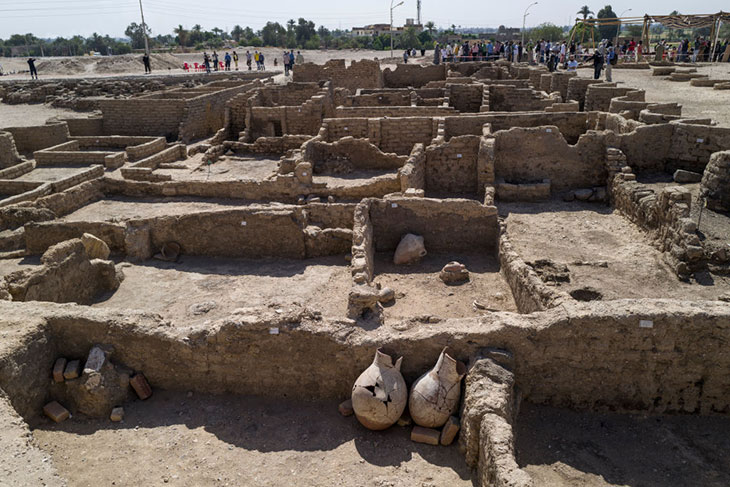Last week, an Egyptian archaeological team working on Luxor’s West Bank announced the discovery of an ancient settlement, referred to as the Rise of Aten. This ‘lost golden city’ has captured the world’s attention thanks to its well-preserved mud-brick buildings and winding walls, and the team’s intriguing finds – from vessels bearing ink inscriptions to items of jewellery, such as rings and scarabs, and tools for spinning and weaving. Archaeologists have identified an area that was used for administration and housing; another for food production (apparently for feeding the city’s workers); and one for workshops. Here, people made mud bricks and produced amulets and decorations from moulds. Objects of glass and metal were also made somewhere at the site.
The settlement was discovered on the desert edge, just beyond the fields, among the mortuary temples built by the great kings of the New Kingdom, and dates to the reign of King Amenhotep III, who ruled Egypt from around 1388–48 BC. The remains of Amenhotep’s own mortuary temple and one of his palace complexes stand nearby, so it seems probable that the settlement’s artisans and workers produced goods for the palace and other local royal sites, including the temples and tombs. This is an exciting discovery, for although ancient Egypt is famous for its fabulously preserved and enigmatic monuments – its pyramids and temples, the Valley of the Kings, the tombs of the nobles – it is the country’s lost settlements that are the real mysteries.
View of the Rise of Aten in April 2021. Photo: Khaled Desouki/AFP via Getty Images

Unlike the stone-built monumental structures, which were designed to last for eternity, most of the mud-brick villages, towns and cities of ancient Egypt have either been destroyed over time or lie hidden beneath modern settlements. This means that archaeologists only get rare or limited glimpses of ancient urban life. Much of what we do know has been reconstructed from atypical settlements found in unusual locations. One of the most significant examples of these is Deir el-Medina, a village established, organised and provided with supplies by the state that stands at the foot of the Theban hills, beyond the green fields and any natural source of water. The village served as home to the workmen who dug and decorated the tombs of the Valley of the Kings during the New Kingdom. Similar workmen’s villages are known from other sites across Egypt, including Lahun, Deir el-Ballas, Abydos and Tell el-Amarna.
Much of what survives of the grand ancient cities of Memphis, Thebes, and Pi-Ramesses is now inaccessible beneath modern fields and housing, leaving only small areas for archaeologists to examine. Thanks to its desert location, however, the remains of the city of Akhetaten, in modern Tell el-Amarna in Middle Egypt, escaped this fate, and the site has been carefully excavated and mapped for over a century. Here, the city centre was a planned precinct containing administrative buildings, offices, storage buildings, and workshops, as well as important temples to the god Aten and two royal palaces (kings had multiple palaces, not only across the country, but also in the same city). The rest of the city was more organically laid out. To the north and south of the centre, in streets branching off the ‘Royal Road’, the key figures in Egypt’s government, priesthood and military lived in single-storey whitewashed villas – the largest in compounds with private gardens, wells, domed granaries, and chapels. Around the villas stood the smaller houses of the less well-off, creating clustered, busy spaces. Garbage heaps often accumulated in the streets between the villas too.
View of the Rise of Aten in April 2021. Photo: Mahmoud Khaled/Getty Images

From what we can reconstruct about Egypt’s cities (based on recent excavations as well as geophysical survey and ancient texts), there were no shops, no pubs, and no official venues for entertainment. Instead, people traded goods privately, or at the local markets, normally held on the riverfront; drank beer with their families and friends at home or at celebrations; and organised their own entertainment, including sports and storytelling, though religious festivals were a frequent event on the calendar. City life, then, was much like village life, just on a much larger scale. And perhaps nowhere would have been grander than Pi-Ramesses, a major city that once stood in the east Delta. As the Egyptians wandered its streets, they would have been mesmerised by grand villas with ornate balconies, palaces, temples to the most important state gods, gardens, military barracks, stables for the king’s horses, chariotry workshops and canals.
At sites like Tell el-Amarna and Deir el-Medina, archaeologists have uncovered evidence regarding the ancient Egyptians’ housing, work, diet, technology and tools, clothing and textiles, household religious activity, food production and storage. The people excluded from the inscriptions of kings and nobles have been rediscovered. Their skeletons tell us about life expectancy, nutrition, diseases and the physical problems they experienced. Human remains from the poorer cemeteries at Tell el-Amarna, for example, show that these individuals lived relatively short lives, their spines damaged, most probably from years of carrying heavy blocks of stone, and their bones affected by malnutrition.
All of this evidence, and the new insights emerging from the Rise of Aten, helps to create a more nuanced picture of life in ancient Egypt – one that moves away from the narratives of the elite, and beyond the popular perception of the Egyptians as a civilisation obsessed with death and religion. This isn’t to say that death and religion weren’t important to the ancient Egyptians. Obviously, they were. No one builds something like the Great Pyramid of Giza as a mildly diverting hobby. It’s just that life was equally important; and the more lost settlements we discover and examine, the clearer the ancient Egyptians’ lives – rather than just their deaths – become.


